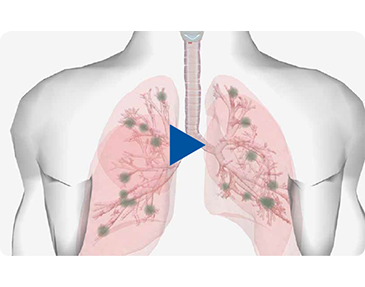Difference
Why Alvesco?
Help your mild-to-moderate asthma patients breathe easier with Alvesco. It's the inhalation aerosol that has small particles of asthma medicine designed to go deep into airways where it may help reduce asthma inflammation.1,2
Alvesco Inhalation Aerosol targets both large and small airways of the lungs.2
Asthmatic inflammation can occur throughout the tracheobronchial tree.5 With a small particle size of ~1-2 µm, Alvesco is able to reach areas of chronic inflammation within the lung.3 In fact, most of the Alvesco that was deposited in the lungs was found in the small airways and alveoli.2
- Aerosol particle size is a key factor in both the extent of lung deposition and the regional distribution within the lung.4
- ICS particle sizes <2 µm in diameter are more likely to reach the small airways of the lungs. Here they can have a targeted effect without as many local adverse effects in the throat and oral cavities as inhalers with larger particle sizes.3,*
*Particle size does
not necessarily correlate with clinical efficacy.
ICS = inhaled corticosteroid.
Due to its small particle size, 52% of the delivered Alvesco Inhalation Aerosol dose was deposited in the lungs.2, *, †, ‡
52%
Deposition in Lungs
Representative 2D lung deposition pattern of 99mtechnetium (Tc)-ciclesonide HFA 320 mcg ex-actuator (400 mcg ex-valve) in an asthmatic patient.
Study Design: Single-dose, open-label,
nonrandomized study
performed in 12 patients with mild asthma. Patients received a
single dose of 99mtechnetium (Tc)-ciclesonide HFA 320 mcg
ex-actuator (400 mcg ex-valve). The primary study variable was
the total and regional distribution of ciclesonide in the lungs,
oropharynx, and exhaled air.2
HFA = hydrofluoroalkane
*Based on 2-dimensional (2D) scintigraphy.
†Scintigraphy is not a valid surrogate for clinical effect.
‡ Percent deposited dose based on 3-dimensional (3D) single-photon emission computed tomography imaging of the
regional
distribution of radio-labeled ciclesonid
†Based on 2-dimensional (2D) scintigraphy
§Scintigraphy is not a valid surrogate for clinical effect
The importance of treating all airways in the lungs.
Treatment with anti-inflammatory drugs can usually reverse some of the airway inflammation and hyperresponsiveness.7
Since inflammation, remodeling, and obstruction can occur in airways of all sizes, it is important for the anti-inflammatory treatment to be able to reach all the airways.8
The total surface area of the small distal airways is much greater than that of the large central airways, so inflammation along these distal surfaces may make a significant contribution to the symptoms of asthma.5
Acute and chronic inflammation can increase bronchial hyperresponsiveness and enhance susceptibility to bronchospasm. Allergens such as pollen, cat dander, and mold spores have particle sizes small enough to reach the smallest airways, where they can trigger asthma symptoms if the airways are inflamed.7,8
Delivering anti-inflammatory medication to distal airways.
- Anti-inflammatory treatment needs to be directed to both the large and small airways in order to reach all the areas that might have inflammation.4
- One study showed that large ICS particles (2.6–4.5 µm diameter) had <20% deposition in the lung, whereas small ICS particles (<2 µm) had >50% lung deposition.8
- Small ICS particles (<2 µm) are more likely to reach the small airways (defined as <2 µm in diameter) where they can exert their anti-inflammatory effect.6,8,13
Steroid receptors.
- Steroid receptors are present in nearly all cells of the respiratory tract, and the smaller airways actually have even more steroid receptors than the large airways.8
- It has been shown that ICSs have a topical anti-inflammatory effect at the location where they are deposited in the lung tissue – not through systemic absorption.8
- Increasing the precision of ICS delivery and deposition has the potential to enhance the anti-inflammatory effects.8
Asthma control.
Inflammation and remodeling in small airways have been shown to contribute to clinical asthma symptoms. Specifically, greater dysfunction of the small airways—but not the large airways—has been associated with worse asthma control.6 It is harder to keep asthma under control if the medicine cannot reach the small airways.
Multiple clinical studies, including rigorous dose-response studies and comparative
clinical trials against CFC inhalers have shown that when small-particle ICS drug
delivery enables more deposition throughout the lung, there is an improvement in
clinical efficacy and comparable asthma control at lower doses.8 Treatment
directed
toward reducing inflammation can reduce airway hyper-responsiveness and improve
asthma control.7
CFC = chlorofluorocarbons
Alvesco in 3D action.
